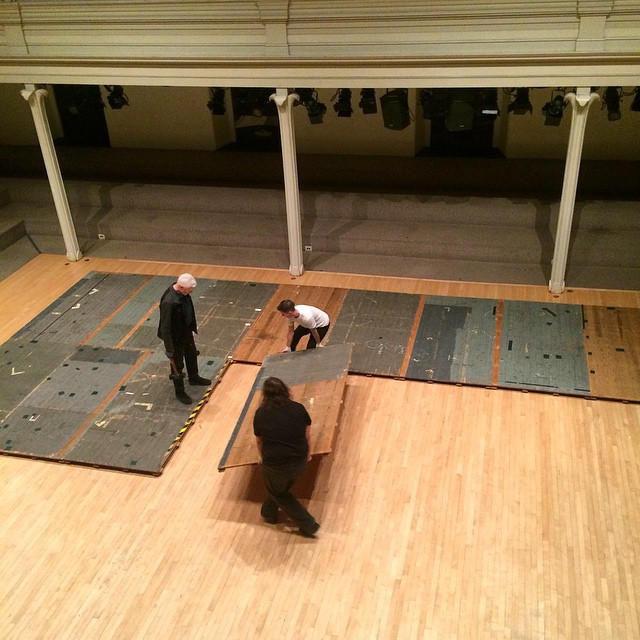Dancing Physics
April 20, 2015
by Emmanuel Iduma
I
I’ve heard rumors that the sexton of St. Marks Church has worked there for a long time. I could verify this easily.* I have chosen, instead, to make estimates of his years of service by watching him clean the platform—the flex of his muscles and gentle mien corresponds to regular work-hours.
In preparation for today’s performance, he moves a dry mop around, focused on the tiniest of dirt. He does this while Yve Laris Cohen and Leo Janks dismantle a sub-floor used for Laris Cohen’s piece Platform. After each fragment of the sub-floor is taken out, the sexton wipes the floor. The chatter of the audience, I suppose, makes his silence resolute, as though through his inaudible motions he remains focused. He collects the trash in a corner. From where I am sitting I am unable to see a particle of dirt. When the sub-floor is cleared, he moves around with a can of cleaning liquid. He sprays required amounts here and there, and then scrubs with a small rag.
In the manner he fulfills his task, I do not think of dexterity or sleight. Even competency seems an ill-fitting characterization. Instead: solemnity. If he believes in God he could be a mute supplicant, performing rites of allegiance without soliciting for favor or reward.
[* Some weeks later, I realized I might have been mistaken. He could have been someone else, not the sexton. Yet the mistake is illuminating.]
II
The sea of blue light fascinated me. I knew it filled the room from overhead lamps tethered to the pillars. I knew Carol Mullins had designed the lighting effects. But in the actual presence of the glow, I understood how kinetic energy proceeds from light: Emily Coates danced towards the edge of the platform. As she moved, speckles of whiter light were projected towards her, until she was dancing in yellow. It seemed a precise combination of unalterable laws of the speed of light with maxims of movement.
Since 2011 Emily Coates has collaborated with particle physicist Sarah Demers. They are making something out of supposedly disparate worlds. The second part of their science-art video “Three Views of the Higgs and Dance” began with a question: If the Higgs Field could be portrayed through dance what would it look like? At first there was a consensual hesitation by the particle physicists who were interviewed, each one lacking an immediate imagination of how a new discovery in physics collided with dance. Then they began to speak, amply using their hands to describe what their eyes could not see:
I think I will see dancers coming in from one side…
A lot of dancers acting together as the Higgs Field, and other dancers who come in to interact with that field…
I guess I imagine a stage completely full of dancers…maybe they’re waving their hands to signal the field…
You have a single dancer trying to move and a whole bunch of dancers pushing, preventing her from going…
I see a sea of indistinguishable things…
There’s a whole lot of people there, without faces, it’s weird, and every once in a while they throw one of them into the air…
You have a bunch of people who are lying on the floor, and they are representative of the Higgs Field…as dancers go by, you have a very heavy weight like Sumo guy, he’s heavy, and the hands are holding him and he can’t move…whereas you have a light ballerina who comes flying through…and she doesn’t get grabbed at all, because she’s so light and swift…
Strange alliances are rife in their collaboration—I am intrigued by the ease with which Coates’s dance vocabulary accommodated physics.

